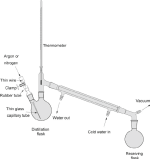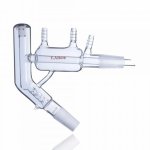G.Patton
Expert
- Joined
- Jul 5, 2021
- Messages
- 2,991
- Solutions
- 3
- Reaction score
- 3,378
- Points
- 113
- Deals
- 1
Introduction
There are many procedures out there for the production of N-methyl-amphetamines (methamphetamines) from various starting materials, such as phenyl-2-propanone (P2P), phenylacetaldehyde or ephedrine, but what if you already have an amphetamine and wanted to add a methyl group to amino group? If you used the first reaction that comes to mind for the conversion, to alkylate the amphetamine with methyl iodide or dimethylsulfate, you would be disappointed, as you would get a mixture of products, most important the N, N-dimethyl-amphetamine (of very low activity), as once the amphetamine has been methylated to methamphetamine, the molecule is much more susceptible to another alkylation, and thus the dimethyl- amphetamine is formed much faster than the remaining amphetamine is alkylated to methamphetamine. Actually, in the reaction mix you would find unreacted amphetamine, N-methylamphetamine, N, N-dimethyl- amphetamine and even some of a quaternary N, N, N-trimethylamphetammonium salt.
To avoid this happening, we must usually resort to indirect methods of introducing the methyl group. One way is to react the amphetamine with formaldehyde (either as an aqueous solution, or as paraformaldehyde) to get the amphetamine formaldehyde imine, which can then be reduced to N-methylamphetamine using a several different reducing agents, for example Al/Hg or Pt/H₂.
In this topic, I described the simplest synthesis of methamphetamine (4) from amphetamine salt via Imine (3) with help of Al/Hg reduction.
To avoid this happening, we must usually resort to indirect methods of introducing the methyl group. One way is to react the amphetamine with formaldehyde (either as an aqueous solution, or as paraformaldehyde) to get the amphetamine formaldehyde imine, which can then be reduced to N-methylamphetamine using a several different reducing agents, for example Al/Hg or Pt/H₂.
In this topic, I described the simplest synthesis of methamphetamine (4) from amphetamine salt via Imine (3) with help of Al/Hg reduction.
Equipment and glassware:
- 5 L Round bottom flask;
- Reflux condenser;
- 1 L Separatory funnel;
- Laboratory grade thermometer (0 °C to 100°C);
- HCl gas apparatus;
- Boiling chips;
- Measuring cylinders 100 and 500 mL;
- Vacuum source;
- 2000 mL x1; 250 mL x3; 500 mL x3; 100 x2 Beakers;
- Glass rod and spatula;
- Laboratory scale (0.01-500 g is suitable);
- Buchner flask (2 L) and funnel (or small Schott filter);
- Retort stand and clamp for securing apparatus;
- Ice water bath;
- Glass rod;
- Rotary evaporator (optional);
- pH indicator paper;
- 1 L Erlenmeyer flask.
Reagents:
- 1 mole Amphetamine salt;
- ~1 L 20% Sodium hydroxide (NaOH) water solution;
- ~700 mL DCM or petrolium ether;
- 1 mole (81 mL 37% or 75 mL 40%) Aqueous formaldehyde (CH2O);
- 350 mL EtOH (ethanole 96-98%);
- ~70 g of Al foil;
- 1.62 g Mercury(II)nitrate (Hg(NO3)2);
- ~500 mL 20 % Hydrochloric acid aq solution (HCl);
- ~200 g Sodium or Magnesium sulphate (Na2SO4 or MgSO4) anhydrous.
Procedure
- You have to get 1 mole amphetamine free (1) base by addition salt of your amphetamine salt (sulphate or phosphate) to 20% NaOH water solution to pH 12. Stirr it for 15 min and extract amphetamine free base by DCM or petrolium ether 3 x 75 mL.
- Prepare Al amalgam. You have to use approximately ~70 g of Al foil and 1.62 g mercury(II)nitrate (Hg(NO3)2) to make amalgam as described in following topic.
- A mixture of 1 mole amphetamine freebase (136 g) and 1 mole aqueous formaldehyde (2) (81 mL 37% or 75 mL 40%) in 350 mL EtOH (ethanole) is poured into a 5 L round bottom flask with reflux condenser and an excess of aluminum amalgam, which was prepared in advance.
- Imine (3) is reduced for approximately two hours, to keep reaction temperature below ~50-60 °C. Cooling have to be applied if the reaction becomes too violent.
- 1 L Of cooled distilled water is added to the reaction mass, aluminum hydroxide solids are filtered off.
- The whole reaction mass is treated with 20 % HCl to pH 3 and extracted by DCM or petrolium ether 3 x 75 mL. DCM extracts are combined. Resulting water layer from filtration is alkalinized by 20% NaOH aq to pH 12 and extracted with DCM or petrolium ether 3 x 75 mL. Organic layers with methamphetamine (4) are combined (from first and second extraction of alkilized water layer), dried over Na2SO4 or MgSO4 anhydrous and concentrated in vacuum.
- Preparation of methamphetamine hydrochloride is carried out by bubbling of dry HCl gas via organic (DCM with methamphetamine) layer. The methamphetamine hydrochloride precipitate is filtered off by suction filtration, dried. Also, you can grow Ice methamphetamine by following methods.
Last edited:


